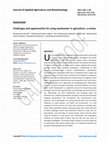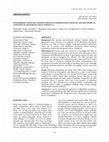Research Articles by Muhammad Suleman

Among abiotic stresses, drought is considered as the most important growth limiting factor, parti... more Among abiotic stresses, drought is considered as the most important growth limiting factor, particularly in arid and semiarid regions. Plant tolerance to drought is mainly associated with the maintenance of plant water status either by reducing water loss through decreasing transpiration or improving plant root capacity to extract more water through osmotic adjustment. In this regard, adequate regulation of plant nutrients may help to maintain or even improve plant water status and hence plant tolerance to drought stress. In the present study, silicon (Si) and plant growth promoting rhizobacteria (PGPR) containing ACC-deaminase activity were evaluated as a tool to improve drought tolerance of tomato (Solanum lycopersicum L.) grown in pots under natural environmental conditions. Nine treatments including, control (irrigation at 60% of field capacity); drought-1 (irrigation at 45% of field capacity); drought-2 (irrigation at 35% of field capacity); drought-1+50 ppm Si; drought-2+50 ppm Si; drought-1+PGPR; drought-2+PGPR; drought-1+50 ppm Si+PGPR; drought-2+50 ppm Si+PGPR were arranged in completely randomized design with 5 replications. Results revealed that both levels of drought stress caused a significant (P ≤ 0.05) reduction in plant growth and yield, K + , Ca 2+ and Mg 2+ accumulation as well as relative water content (RWC) while increase in Na + concentration and electrolyte leakage. However, supplementation of Si and PGPR inoculation increased plant K + accumulation, RWC while reduced Na + uptake and electrolyte leakage, and subsequently improved fruit yield by 18.34% with Si, 22.80% with PGPR and 30.44% with Si+PGPR at drought-1 while 31.13% with Si, 35.32% with PGPR and 42.36% with Si+PGPR at drought-2 compared to drought stressed plants without any amendment. Ameliorative effects of Si or/and PGPR were mostly more pronounced at drought-2 compared to drought-1. Furthermore, Si and PGPR were more effective to alleviate drought stress effects when applied in combination compared to their individual application. Silicon and PGPR-induced increase in K + , Ca 2+ and Mg 2+ accumulation, and RWC while decrease in electrolyte leakage were the main factors associated with drought tolerance of tomato.
Papers by Muhammad Suleman

2017. Challenges and opportunities for using wastewater in agriculture: a review. J. Appl. Agric.... more 2017. Challenges and opportunities for using wastewater in agriculture: a review. J. Appl. Agric. Biotechnol., 2(2): 1-20 ABSTRACT se of wastewater for irrigating the agricultural land is becoming a common and a widespread practice throughout the world, particularly in arid and semiarid regions where freshwater resources are insufficient to meet water demand. According to estimates, 20 million hectares area on global scale is being irrigated with treated, partially treated and untreated wastewater, contributing to food security. Increasing water scarcity, industrialization, urbanization, increasing urban wastewater flows due to expanded water supply and sewerage services, nutrient value, consistency and reliability in supply are the key drivers for the widespread use of wastewater for irrigation. These drivers are expected to become even more powerful in the near future, making wastewater use in agriculture an emerging priority. Wastewater consists of mainly municipal wastewater, industrial effluents and storm water runoff. Wastewater is a potential resource for overcoming water shortage, and has both opportunities and challenges associated with its use. Wastewater can have multifaceted uses including urban and industrial uses, artificial groundwater recharge, crop land and landscape irrigation, aquaculture, and recreational and environmental uses. However, use of wastewater can involve potential risks such as harmful influences on plant growth, soil health and environment. It is also supposed to be the carrier of certain toxic substances including salts, heavy metals, pesticide residues, poisonous gases and a wide spectrum of enteric pathogens which have deleterious effects on crops, soil, air, groundwater, and eventually on human beings. Social concerns about using the produce of crops grown with wastewaters and subsequent influence on market value of these crops are also the main areas of thorough investigation. The present paper reviews the current literature on wastewater with focuses being made on its potential benefits and hazards on plant growth and soil health. U Ashraf et al. 2017 J. Appl. Agric. Biotechnol. 2017 2(2): 1-20 2 Copyright© PMAS-Arid Agriculture University Rawalpindi, Pakistan http://jaab.uaar.edu.pk

Background The growth and biological nitrogen fixation ability of leguminous crops is known to be... more Background The growth and biological nitrogen fixation ability of leguminous crops is known to be enhanced by the Rhizobium inoculation. However, very little is known whether exogenously applied polyamines alone and in mixture with Rhizobium inoculation further boost-up germination, growth and nitrogenase activity of legumes. Methodology The present study was carried out to investigate the effect of polyamines (spermine and putrescine) and abscisic acid (ABA) alone and in combination with Rhizobium inoculum on germination and growth rates, and nitrogenase activity of mungbean (cv. NM-92). The ABA, spermine and putrescine were applied as seed soaking treatments where seeds were soaked 6.0 hours prior to sowing for studying their effect on germination rate, germination percentage and fresh weight of seedlings. But in case of drought conditions, spermine, putriscine and ABA were applied as foliar spray each at 10-5 M. Results Maximum germination percentage (66.2-100%) and seedling fresh weight (0.78-0.95 g) of mungbean were obtained as a result of seed soaking with spermine + inoculum that were 13-23% and 14-22% higher, respectively compared to control. While, ABA treatment showed reduction in seed germination percentage and fresh weight of seedlings. Compared to all other treatments, effect of spermine alone and in the presence of Rhizobium inoculum was more pronounced in reducing proline accumulation and enhancing protein content in mungbean seedlings under normal, drought stressed and re-watered conditions. Conclusion It can be concluded that application of Rhizobium inoculum in combination with polyamines especially spermine significantly increased the germination, seedling growth, nitrogenase activity and protein content in the leaves of mungbean.









Uploads
Research Articles by Muhammad Suleman
Papers by Muhammad Suleman